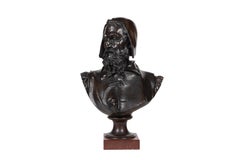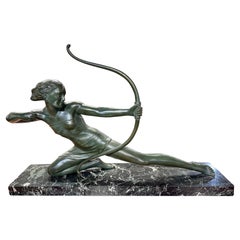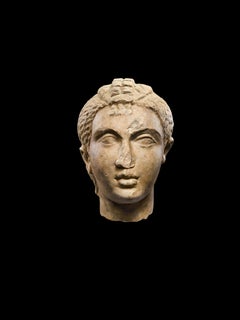Albert Ernest Carrier-Belleuse Art
Albert-Ernest Carrier-Belleuse was a French sculptor. Carrier-Belleuse was born on 12th June 1824 at Anizy-le-Château, Aisne, France. He began his training as a goldsmith's apprentice. He was a student of David d'Angers and briefly studied at the École des Beaux-Arts. His career is distinguished by his versatility and his work outside France, in England between 1850–55 and in Brussels around 1871. His name is perhaps best known because Auguste Rodin worked as his assistant between 1864 and 1870. The two traveled to Brussels in 1871 and by some accounts, Rodin assisted Carrier-Belleuse's architectural sculpture for the Brussels Stock Exchange.
1870s French School Albert Ernest Carrier-Belleuse Art
Marble
1860s French School Albert Ernest Carrier-Belleuse Art
Terracotta
1860s French School Albert Ernest Carrier-Belleuse Art
Bronze
1870s French School Albert Ernest Carrier-Belleuse Art
Bronze
19th Century Albert Ernest Carrier-Belleuse Art
Marble, Bronze
Mid-19th Century Albert Ernest Carrier-Belleuse Art
Bronze
19th Century Academic Albert Ernest Carrier-Belleuse Art
Bronze
Early 1900s Aesthetic Movement Albert Ernest Carrier-Belleuse Art
Enamel
19th Century Baroque Albert Ernest Carrier-Belleuse Art
Marble, Bronze
Mid-19th Century French School Albert Ernest Carrier-Belleuse Art
Bronze
Late 19th Century Victorian Albert Ernest Carrier-Belleuse Art
Bronze
1930s Art Deco Albert Ernest Carrier-Belleuse Art
Marble, Bronze
15th Century and Earlier Albert Ernest Carrier-Belleuse Art
Marble
1960s American Modern Albert Ernest Carrier-Belleuse Art
Bronze
Early 19th Century Albert Ernest Carrier-Belleuse Art
Marble, Bronze
18th Century Old Masters Albert Ernest Carrier-Belleuse Art
Marble
1830s French School Albert Ernest Carrier-Belleuse Art
Marble, Bronze
Late 20th Century French School Albert Ernest Carrier-Belleuse Art
Plaster
Early 1800s French School Albert Ernest Carrier-Belleuse Art
Marble
1980s Surrealist Albert Ernest Carrier-Belleuse Art
Bronze
1930s Art Deco Albert Ernest Carrier-Belleuse Art
Marble, Bronze
2010s French School Albert Ernest Carrier-Belleuse Art
Resin, Varnish, Acrylic
19th Century Albert Ernest Carrier-Belleuse Art
Marble, Bronze
1860s French School Albert Ernest Carrier-Belleuse Art
Bronze
Late 19th Century Romantic Albert Ernest Carrier-Belleuse Art
Bronze
19th Century Romantic Albert Ernest Carrier-Belleuse Art
Bronze




